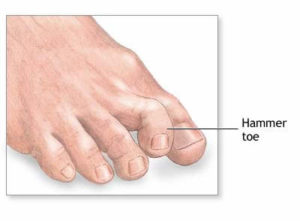Hammertoes are the bending of one or more joints of the toes because a muscle is not working properly or is too weak. Heredity, arthritis, ill-fitting shoes or even injury can lead to hammertoes.

Symptoms of Hammertoes
- When wearing shoes, pain or irritation of the toe
- Corns and calluses on the toe, between toes or on the ball of the foot.
- Inflammation, redness or a burning sensation.
- Deformed toe
- In the most severe cases, open sores may develop.
Treatment
There are a variety of options available based on the type of hammertoe and problems caused by it:
- Padding: Padding the corn or callus can sometimes help. Do not use medicated pads. They contain a small amount of acid that can be harmful and lead to open sores.
- Orthotic devices: a custom foot orthotic inside your shoe may help control the balance of the muscles and tendons
- Medication: sometimes an anti-inflammatory is helpful to reduce pain and inflammation
- Strapping/Taping: apply tape to help realign and maintain the position of the toe
- Surgery: the last resort
Surgery is generally the last resort when it comes to treatment of hammertoes. Typically, surgery is done when the hammertoe is so rigid and painful that none of the above treatments help or an open sore develops. Often patients with hammertoes have other foot problems that may be surgically corrected at the same time. The extent of the deformity, the number of toes involved, age, activity level and other factors must be taken into account when selecting the right procedure or combination to be performed.
Next Steps
Schedule an appointment for a full evaluation of your feet. During your appointment, the doctor will advise the best treatment for your hammertoes. To schedule call 402.315.4406 or go online at momentumfootandankle.com/schedule.





Call Us Today: 402.315.4406